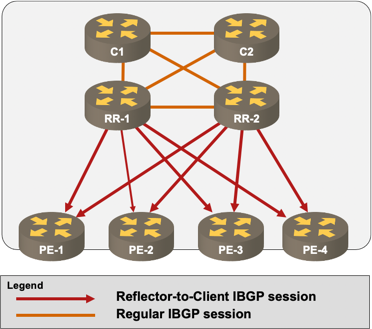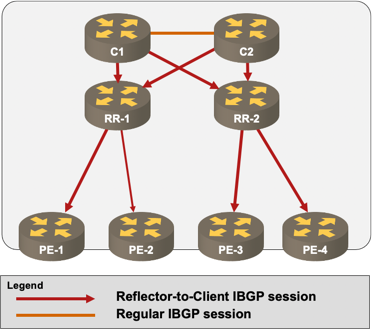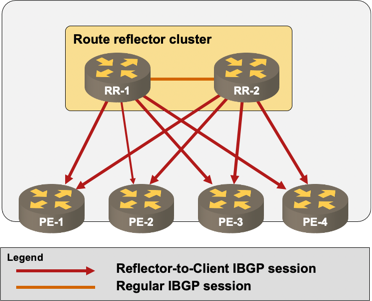… updated on Friday, November 20, 2020 09:24 UTC
BGP Route Reflector Details
BGP route reflectors have been supported in Cisco IOS well before I started to develop the first BGP course for Cisco in mid 1990s. It’s a very simple feature, so I was pleasantly surprised when I started digging into it and discovered a few rarely known details.
The Basics
Route reflector is an IBGP feature that allows you to build scalable IBGP networks. The original BGP protocol (RFC 1771) contained no intra-AS loop prevention mechanism; routers were therefore prohibited from sending routes received from an IBGP peer to another IBGP peer, requiring a full-mesh of IBGP sessions between all BGP routers within an AS.
The next revision of the BGP standard (RFC 4271) already included references to the BGP Route Reflector functionality defined in RFC4456 and augmented in RFC7606. RFC 4271 defines a new attribute (cluster list) which can detect route propagation loops within an AS, allowing us to build any IBGP topology we wish as long as we follow a few simple rules.
Route Reflector Rules
A BGP router implementing route reflector functionality propagates BGP routes according to these rules:
- Locally originated routes and routes received from EBGP neighbors and selected as best routes are propagated to all BGP peers (internal and external).
- Routes received from an IGBP peer that is not a route-reflector client and selected as best routes are propagated to all EBGP peers and all IGBP peers configured as route-reflector clients.
- Routes received from a route-reflector client and selected as best routes are propagated to all BGP peers (internal and external).
Whenever an IBGP route is reflected (propagated to another IBGP peer), the route reflector appends two optional, non-transitive attributes to the BGP route:
- If the route does not have the Originator ID attribute (it has not been reflected before), the router ID of the IBGP peer from which the route has been received is copied into the Originator ID attribute.
- If the route does not have the Cluster list attribute, it’s added to the route.
- The value configured with the bgp cluster-id router configuration command (or the router ID of the route reflector if the cluster-id is not configured) is prepended to the Cluster list attribute.
Route reflector does not change or remove any other attributes of the reflected routes (even non-transitive attributes), ensuring that the IBGP routes are not changed within the autonomous system. The next-hop-self neighbor configuration parameter or (most of the) set options of outbound route-map configured on route-reflector clients are ignored for reflected routes.
Exceptions:
- BGP next-hop can be changed set ip next-hop route map command or with neighbor next-hop-self all feature introduced to support large-scale DMVPN networks using IBGP.
- Standard and extended BGP communities are removed from the reflected routes unless the neighbor send-community [both] is configured on the route reflector.
- The link bandwidth community is removed from reflected route if the route-reflector performs IBGP multipath load-sharing for that route.
Monitoring Route Reflection
The route reflector-related BGP attributes attached to a BGP route (Originator and Cluster list) can be inspected with the show ip bgp prefix command:
Edge#show ip bgp 10.2.2.0
BGP routing table entry for 10.2.2.0/24, version 12
Paths: (1 available, best #1, table default)
Flag: 0xA20
Not advertised to any peer
65001
10.0.1.1 (metric 129) from 10.0.1.3 (10.0.1.3)
Origin IGP, metric 0, localpref 100, valid, internal, best
Originator: 10.0.1.1, Cluster list: 10.0.1.3
The same command executed on a route reflector will also indicate whether a route was received from a route-reflector client (and will thus be reflected to all IBGP peers):
RR#show ip bgp 10.2.2.0
BGP routing table entry for 10.2.2.0/24, version 18
Paths: (2 available, best #2, table default)
Multipath: eBGP iBGP
Flag: 0x1A20
Advertised to update-groups:
1
65001, (Received from a RR-client)
10.0.1.2 (metric 65) from 10.0.1.2 (10.0.1.2)
Origin IGP, metric 0, localpref 100, valid, internal, multipath
65001, (Received from a RR-client)
10.0.1.1 (metric 65) from 10.0.1.1 (10.0.1.1)
Origin IGP, metric 0, localpref 100, valid, internal, multipath, best
The route propagation policy of a route reflector is also displayed in the show ip bgp update-group printout:
RR#show ip bgp update-group
BGP version 4 update-group 1, internal, Address Family: IPv4 Unicast
BGP Update version : 22/0, messages 0
Route-Reflector Client
Community attribute sent to this neighbor
Extended-community attribute sent to this neighbor
Update messages formatted 59, replicated 47
Number of NLRIs in the update sent: max 1, min 0
Minimum time between advertisement runs is 0 seconds
Has 2 members (* indicates the members currently being sent updates):
10.0.1.2 10.0.1.4
BGP version 4 update-group 2, internal, Address Family: IPv4 Unicast
BGP Update version : 22/0, messages 0
Community attribute sent to this neighbor
Extended-community attribute sent to this neighbor
Update messages formatted 5, replicated 0
Number of NLRIs in the update sent: max 1, min 1
Minimum time between advertisement runs is 0 seconds
Has 1 member (* indicates the members currently being sent updates):
10.0.1.1
Loop Detection and Avoidance
The BGP routers implementing RFC 1966 (original route reflector RFC) use the following mechanisms to detect route-reflector-related loops:
- If the Originator ID in an incoming IBGP route update is equal to the BGP router ID, the update is ignored (reflected route was propagated back to its originator).
- If the Cluster ID of a route-reflector appears in the Cluster list attribute of an incoming IBGP update, the update is ignored (route reflector loop).
Although the mechanisms specified in RFC 1966 ensure loop-free IBGP operation regardless of the actual topology of the IBGP sessions, RFC 4456 added new route selection rules that improve the actual convergence within an AS and reduce the amount of BGP updates propagated across the AS:
- Routes with shorter Cluster list attribute are preferred. This rule ensures that all routers select routes with minimum number of reflections, significantly reducing the amount of unnecessary BGP updates (remember: only best routes selected by a route reflector are reflected to its clients).
- The Originator ID attribute of a reflected route should be used as the Router ID attribute when comparing otherwise identical IBGP routes, ensuring the stability of route selection across AS regardless of the route reflectors.
Route Reflector Design Rules
Traditional design rules recommended an IBGP full mesh of route reflectors or other core routers, combined with route reflector clients at the network edge:

BGP route reflectors combined with IBGP full mesh between core routers
Alternatively you could build a hierarchy of route reflectors with mid-range route reflectors being clients of core route reflectors:

A hierarchy of BGP route reflectors
With the improved IBGP loop avoidance, you could use more relaxed designs, ranging from route-reflector-client being configured on every IBGP neighbor to designs where the edge routers act as route reflector clients and all other BGP routers in the AS act as route reflectors.

IBGP session topology with bidirectional route-reflector-client configuration
Cluster-ID is Obsolete
Cisco IOS implementation of route reflector functionality supports the bgp cluster-id parameter, which is used in the Cluster list attribute instead of the Router ID. The cluster-id parameter is useful in redundant route reflector scenarios where multiple route reflectors serve the same set of clients, but can lead to partial connectivity when multiple IBGP sessions are disrupted (more details).

Cluster of redundant BGP route reflectors
The revised BGP route selection rules ensure that a route reflector in a cluster always prefers route from a client (with shorter Cluster list) over a reflected route, thus making the bgp cluster-id parameter obsolete. You should not use the bgp cluster-id in new designs to increase the resilience of your network.
Further Reading
- Can BGP Route Reflectors Really Generate Forwarding Loops?
- Mixed Feelings about BGP Route Reflector Cluster ID
- BGP Route Reflector update groups (technical details)
- BGP next hop processing
- Can We Trust BGP Next Hops (Part 2)?
- Running BGP Route Reflector in a Virtual Machine
- Building BGP Route Reflector Configuration with Ansible/Jinja2

Referering to this article "http://wiki.nil.com/BGP_route_reflectors" can you please confirm if this statement that has been specified in the "Route Reflector Rules Section" is actually true.
"An IBGP route received from a route-reflector client is sent to all IBGP peers, including the client from which it was received."
I tried researching this a bit as I was curious and no other discussion has explicitly stated that the route is reflected back to the client from which it was received. Infact this would actually go against the split horizon rule. The RFC doesn't mention of this either (Atleast I couldn't find it in the RFC:-)
Please could you confirm. Thx for help.
Which community will be sent if only "neighbor {ip-address} send-community" is configured?
Thanks, Pete
Without this option, no communities will be sent to the BGP neighbor, after it has been configured, the router will propagate communities attached to BGP entries in its BGP table to the neighbor.
http://www.cisco.com/en/US/docs/ios/iproute/command/reference/irp_bgp3.html#wp1016586
Thanks, Pete
Aggregation is done using
aggregate-address prefix mask summary-only
Does anybody know anything about this??? Thanks
Ivan Confused on last bit "You should not use the bgp cluster-id in new designs to increase the resilience of your network." please confirm what is means
thank you
"Cluster-ID is Obsolete".
do you mean we should not use same cluster-id for same group of route reflectors ?
You can if you wish, but it's no longer important that you do so. Please see https://blog.ipspace.net/2022/02/bgp-rr-cluster-myths.html for details.